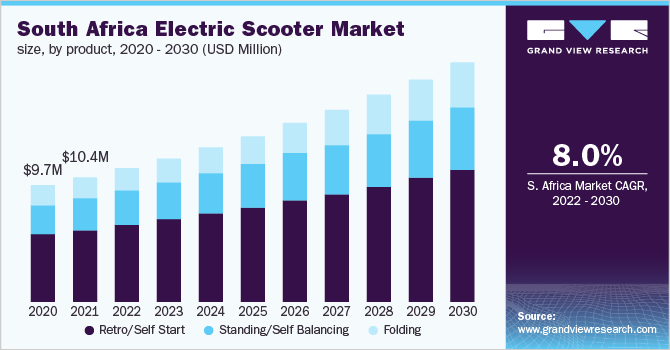Africa Electric Scooter Industry Overview
The Africa electric scooter market size was valued at USD 20.7 million in 2021 and is expected to expand at a compound annual growth rate (CAGR) of 7.5% from 2022 to 2030. Rapid urbanization, high fuel prices, and increasing vehicular pollution encourage people to switch from Internal Combustion Engines (ICE) to Electric Vehicles (EV). E-scooters are lightweight, easy to operate, and contribute to the goal of zero carbon emission; thus, they are widely used in the country. In addition, countries such as Egypt and Morocco are prominent destinations for foreign visitors. Tourists prefer rental E-scooters for local traveling and adventuring, driving the demand. An increase in the adoption of electric scooters to reach schools and colleges is expected to propel the growth of e-scooters. Although various factors are driving the demand, the COVID-19 pandemic has severely impacted the sales of EVs.

The region was witnessing greater electric vehicle adoption till 2019. However, the COVID-19 pandemic posed a severe challenge. Global restriction, disruption of the supply chain, and unavailability of vaccines have impacted the tourism, transportation, and automobile sectors. Battery electric vehicles such as passenger cars, pickup trucks, and buses have witnessed a sharp decline in sales; the electric scooters were no escape. Electric scooter sales are highly dependent on tourists; due to the global lockdown and travel restrictions, foreign visitors refrained from movement across countries. This factor has reduced the demand for electric scooters, and the market witnessed negative growth during 2019 and the first half of 2020.
Gather more insights about the market drivers, restraints, and growth of the Africa Electric Scooter market
Electric scooters exhibit zero emission characteristics, cost-effective, and enable users to avoid road congestion, thus gaining consumers traction. They are adopted for short-distance travel and are replacing conventional bicycles. Scooters are easy to operate, faster than a bicycle, and reduce the effort of peddling, thus widely used by schools & college students. In addition to this, kick-start electric scooters are available for adults, more suitable for local adventuring.
Urbanization in Africa is higher than in other developing economies; the rapidly growing population is straining existing transport and energy infrastructure. Most of the vehicles used for transportation are fuel-based, thus creating a high oil demand. The problems such as fuel scarcity, high fuel prices, and pollution occur due to the use of ICEs. Therefore, Africa needs alternative transport that reduces fuel dependency. The electric vehicles are battery-powered and eliminate the emission from the exhaust pipe, thus a potential solution.
The hospitality industry has been vital for the African economies. According to the World Travel and Tourism Council, in 2018, the travel and tourism sector had contributed $42.1 Million to the sub-Saharan Africa GDP. The region had over 13 million tourists in Egypt and 56 million in Sub-Saharan Africa. As more tourists are visiting for leisure activities in the area, there is a great demand for transportation. Traveling and site seeing in the region easily be possible by electric scooters. Thus, the sector is expected to drive the demand for electric scooters.
Global automobile manufacturers are introducing rental electric scooters to Africa. Companies such as Lime, Baddel, and Bird offer rental electric scooter services in Dubai, Egypt, and Morocco. Vehicles provided by the companies are affordable, sustainable, and reduce carbon emissions, widely adopted by young people. The initiative taken by the global automobile manufacturers is expected to encourage the local electric vehicle manufacturers to produce advanced electric scooters and provide tough competition.
Browse through Grand View Research's Automotive & Transportation Industry Related Reports
Electric Three Wheeler Market - The global electric three wheeler market size was valued at USD 829.5 million in 2021 and is anticipated to register a compound annual growth rate (CAGR)of 7.5 % during the forecast period.
Electric Vehicle Market - The global electric vehicle market demand was estimated at 2,373.5 thousand units in 2019 and is expected to witness a CAGR of 41.5% 2020 to 2027.
Africa Electric Scooter Industry Segmentation
Grand View Research has segmented the Africa electric scooter market based on product, battery, voltage type, and country:
Africa Electric Scooter Product Type Outlook (Revenue, USD Million, 2018 - 2030)
- Retro Electric Scooter
- Standing/Self-balancing Electric Scooters
- Folding Electric Scooters
Africa Electric Scooter Battery Type Outlook (Revenue, USD Million, 2018 - 2030)
- Sealed Lead Acid
- NiMH
- Li-Ion
Africa Electric Scooter Voltage Type Outlook (Revenue, USD Million, 2018 - 2030)
- 24V
- 36V
- 48V
- Greater than 48V
Africa Electric Scooter Country Outlook (Revenue, USD Million, 2018 - 2030)
- South Africa
- Morocco
- Algeria
- Egypt
- Rest of Africa
Market Share Insights:
May 2021: Yadea Technology Group Co., Ltd., the major player in the electric scooter market launched a range of electric vehicles such as kick scooters, motorcycles, and mopeds. The launch of these new electric vehicles demonstrates its commitment to remaining at the forefront of electric vehicle innovation and delivering its growth strategy to maintain its dominant position.
Key Companies profiled:
Some prominent players in the Africa Electric Scooter Industry include
- Honda Motor Co Ltd
- KTM AG
- Mahindra GenZe
- Peugeot Scooters
- Ninebot Limited
- Suzuki Motor Corporation
- Terra Motors Corporation
- Vmoto Limited
- Yadea Technology Group Co., Ltd.
- Yamaha Motor Company Limited
Order a free sample PDF of the Africa Electric Scooter Market Intelligence Study, published by Grand View Research.


No comments:
Post a Comment